
CARRIER MULTIMISSION SINGLE SEAT TWIN ENGINED FIGHTER
|
HISTORY |
The program's genesis: from the U.S.A.F. YF-17 to the Navy and Marine F/A-18
In the U.S.A. the 90's period
was marked by the simultaneous withdrawal of several planes from the Carrier
Air Wing inventory. The U.S.N. lost its A-6s, it's A-7s and was beginning
to withdraw the F-14. The U.S.M.C. had to face the loss of the F-4S, the
A-6, the A-4 and of the RF-4B. A typical CAW in 1990 was made of: two
squadrons of F-14s, one of A-6s, one of A-7s, one of E-2Cs, one of S-3s,
and several helicopter detachments. Today a CAW looks more like this:
one squadron of F-14s, three of F/A-18, and the E-2Cs, S-3s and helicopters.
This shows the importance of the Hornet for U.S. carrier aviation.
Paradoxically, the Hornet's history is closely linked to that of the U.S.A.F.'s
F-16 Fighting Falcon. In 1972 the Air Force initiated a competition for
the development of a new light aircraft for dogfighting, fitted with a
canon and AIM-9 Sidewinders only, to complement the F-4 and the F-15,
more designed as heavy air superiority fighters. This aircraft was to
be the first of a new generation of fighters, equipped with digital Fly-by-Wire
(FBW) controls and a small side-stick. The competition saw General Dynamics'
YF-16 face to face with Northrop's YF-17.
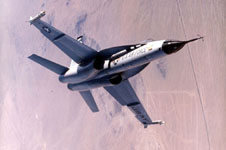 In those times of budgetary
restraint, the American Congress considered this small fighter to
be the perfect sidearm for the F-14 on aircraft carriers. It compelled
the U.S. Navy, which at the time was seeking to replace its ageing
attack planes, to buy the same plane as the U.S.A.F., the winner
of the YF-17/YF-18 competition. The U.S.A.F. eventually chose
the YF-16, but this decision did not satisfy the Navy, which favoured
the YF-17. During the YF-18's development phase, the plane saw so many
modifications that the decision was taken to change it's name, first to
F-18 Hornet, and then to F/A-18 Hornet. The Marines were much more reluctant
to get the Hornet, for three reasons: they had just bought the Harrier
which suited them better; the Hornet's developments cost were rising every
day; and finally the Hornet's performances, especially its range, were
inferior to that of the A-7 Corsair II. The first predictions called
for 11 pre-production aircraft and 1,366 production aircraft, to equip
24 U.S.N. squadrons and 6 U.S.M.C. squadrons. Added to that were 332 aircraft
for Reserve units, and 124 aircraft kept for attrition. Final production
numbers were lower.
In those times of budgetary
restraint, the American Congress considered this small fighter to
be the perfect sidearm for the F-14 on aircraft carriers. It compelled
the U.S. Navy, which at the time was seeking to replace its ageing
attack planes, to buy the same plane as the U.S.A.F., the winner
of the YF-17/YF-18 competition. The U.S.A.F. eventually chose
the YF-16, but this decision did not satisfy the Navy, which favoured
the YF-17. During the YF-18's development phase, the plane saw so many
modifications that the decision was taken to change it's name, first to
F-18 Hornet, and then to F/A-18 Hornet. The Marines were much more reluctant
to get the Hornet, for three reasons: they had just bought the Harrier
which suited them better; the Hornet's developments cost were rising every
day; and finally the Hornet's performances, especially its range, were
inferior to that of the A-7 Corsair II. The first predictions called
for 11 pre-production aircraft and 1,366 production aircraft, to equip
24 U.S.N. squadrons and 6 U.S.M.C. squadrons. Added to that were 332 aircraft
for Reserve units, and 124 aircraft kept for attrition. Final production
numbers were lower.
From the beginning the plane was called F/A-18, a designation that supposed
a fighter (F) and an attack (A) role. The single seater was designated
F/A-18A, and the two seater was originally designated TF-18, but was renamed
F/A-18B. This two seater was capable of combat missions, with the rear
cockpit identical to the front one.
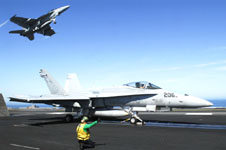 The F/A-18 made its first flight on November 18th 1978, and the F/A-18B
on October 25th 1979. The Hornet reached U.S.N. squadrons in February
1981, with VFA-125. The Hornet was operational in the U.S.M.C. in March
1983 with VMFA-314.
The F/A-18 made its first flight on November 18th 1978, and the F/A-18B
on October 25th 1979. The Hornet reached U.S.N. squadrons in February
1981, with VFA-125. The Hornet was operational in the U.S.M.C. in March
1983 with VMFA-314.
400 A and B versions came out of the assembly line. Furthermore, 483 Hornets
of all versions (A, B, C and D) were manufactured for foreign countries:
Australia, Canada, Finland, Kuwait, Malaysia, Spain, Switzerland and Thailand.
Upon its service entry, the Hornet was immediately appreciated for its
performances, its versatility, and its availability. In the U.S.N., the
Hornet flew on average three times more than other planes, but needed
half the maintenance time. The Hornet can perform the following missions:
air superiority, escort, reconnaissance, SEAD, CAP, CAS, Fast FAC, interdiction
and deep strike. 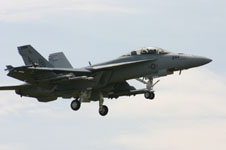 In April 1986; the U.S.N. and the U.S.A.F. attacked Libya during operation
El Dorado Canyon. During the operation, F/A-18As were based on the U.S.S.
Coral Sea and flew SEAD missions (with the AGM-88 HARM missile) against
SAM sites around Benghazi.
In April 1986; the U.S.N. and the U.S.A.F. attacked Libya during operation
El Dorado Canyon. During the operation, F/A-18As were based on the U.S.S.
Coral Sea and flew SEAD missions (with the AGM-88 HARM missile) against
SAM sites around Benghazi.
The main evolution of the Hornet was the upgrade to the C and D versions
in 1986. Whereas the F/A-18C was
an upgraded version of the A, the F/A-18D was an entirely new plane,
for the U.S.M.C..The F/A-18C is different from the A in that its
avionics are new and that it carries the AIM-120 AMRAAM and AGM-86
Maverick missiles. The cockpit was modified to accommodate a navigation
FLIR, night vision goggles (NVGs), and multifunction color displays.
It flew for the first time on September 3rd 1987. The F/A-18D received
the same modifications, but the backseat cockpit lacked flight controls. The second pilot was replaced by a weapons system officer
(WSO). The U.S.M.C. uses this Hornet for deep strike, missions for which
a second crewmember is welcomed. The F/A-18D made its first flight on
June 5th 1988, and entered service in May 1991 with VMFA(AW)-121.
Eventually, 1,048 Hornets in all four versions were produced, the last
airframe rolling out of the factory on September 30th 2000, while the
F/A-18E was entering production.
The " tricolor " Hornet : the F-18(FN)
A first try in the late
70's
Northrop and McDonnell-Douglas' project was found very interesting by
the French Air Force and Navy, which were seeking to replace the interceptors
in their squadrons.
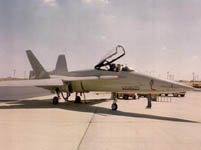 The Air Force was already studying the Mirage 2000 (first flight on March
11th 1978) and the big Mirage 4000 (still on the drawing board, but similar
in performance to the F-14 Tomcat) as a replacement for the ageing Mirage
IIIC, but decided to try the American YF-17/18 Hornet. As for the Navy,
it was replacing its Etendard IVM with Super Etendards, but needed an
aircraft capable of fulfilling the Crusader's
(in service since 1964) fleet defence mission, but also capable of strike
missions to support the Super Etendards and replace the final Etendard
IVMs. Some 40 aircraft were required. That was the situation Northrop
was facing when it contacted the Air Force, which was supposed to send
two pilots from the BPM (Bureau des Programmes de Matériel / equipment supplying bureau) to the USA. Yet since the aircraft was a
carrier-born fighter, Northrop was put into contact with the Navy, not
the Air Force.
The Air Force was already studying the Mirage 2000 (first flight on March
11th 1978) and the big Mirage 4000 (still on the drawing board, but similar
in performance to the F-14 Tomcat) as a replacement for the ageing Mirage
IIIC, but decided to try the American YF-17/18 Hornet. As for the Navy,
it was replacing its Etendard IVM with Super Etendards, but needed an
aircraft capable of fulfilling the Crusader's
(in service since 1964) fleet defence mission, but also capable of strike
missions to support the Super Etendards and replace the final Etendard
IVMs. Some 40 aircraft were required. That was the situation Northrop
was facing when it contacted the Air Force, which was supposed to send
two pilots from the BPM (Bureau des Programmes de Matériel / equipment supplying bureau) to the USA. Yet since the aircraft was a
carrier-born fighter, Northrop was put into contact with the Navy, not
the Air Force.
The embassy's deputy naval attaché in Washington, Michel Debray
(14.F squadron CO from March 1970 to September 1971; in post in Washington
since 1976) took things in hand.
Northrop shared the production, but also the financing, with McDonnell-Douglas,
according to the version produced: for a carrier-born airframe Northrop
received 40% of the financing and of the work; but for a land-based airframe
it received 60% of the share. This explains why Saint-Louis based McDonnell-Douglas
never insisted on exporting the plane, since the US Navy's huge order
was more than it had ever dreamt of! On the contrary, Northrop was moving
heaven and earth to sell it's land-based version of the plane, the F-18L
(L for land) Cobra, the only solution to make money. These test flights were
planned for June 28th 1978 at the huge Edwards test bed in California.
The airframe was the YF-17, transformed into an YF-18L Cobra. Four
flights were programmed: two per pilot, the first one to test performances
(climb rate, maximum Mach speed, low speed) and the second one to
test flight characteristics (combat, aerobatics…).
The main differences with the production F-18 were the wing shape;
similar to that of the F-5, its lighter weight; because of the absence
of weapons (except for two mock wingtip sidewinders)and avionics,
and its engines; GE YJ101s instead of F404s. The French pilots were
stunned by the plane's features and by its unbelievable manoeuvrability; the engines were so powerful that on touchdown you had to quickly
shut one engine off, instead of what the brakes would overheat trying
to slow the plane down. Vice-admiral Debary (ret.) comments
: the flights went perfectly, and we had a chase F-5, flown by
Hank Chouteau, Northrop chief test pilot. I had the satisfaction
of really impressing him during a flight when I saw him coming from
4 o'clock. I said to myself "now's the time to see what the plane
is really worth", and broke him up, full AB and stick to the stomach…until
I found myself in his 6 o'clock incredibly easily. It was great
to hear him ask where I was, and to tell him "in your 6 o'clock,
in firing position" !
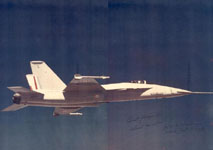 During the course
of this flight while performing a loop without the afterburners
and without pulling too hard, I found myself in a touchy situation
at the top of the loop but with my speed decreasing fast, down to
60 knots (very slow for this kind of plane). I engaged the AB and
realised that the plane was climbing and accelerating, which was
astonishing and more proof of the plan's qualities. I has the opportunity
to debrief the flight (with Northrop test equipment to prove my
claims) with Canadian pilots in charge of their fighter replacement,
and I sincerely think I was part of the their decision to choose
the F-18. After his first flight, colonel Bonnet told me as
he was climbing down the ladder "the Mirage 2000 will never do what
this plane can do". As far as I was concerned I was not convinced
by the plane's performances strictly speaking which were inferior
to that of the Crusader (Mach 1.6 instead of 1.8 and a smaller climb
rate), but it's handling and thrust-to-weight ratio were really impressive.
Since then I have always thought, and still do openly, that the best
fighter for our carriers was the F-18. In spite of the plane's excellent results, the French Air Force (even
if the dice were loaded) chose the Mirage 2000, which it ordered in it's
"C" fighter, "B" training and "D" strike versions, and more recently upgraded
old 2000Cs into 2000-5s. As for the Navy, it delayed its announcement
of the new fighter another ten years.
During the course
of this flight while performing a loop without the afterburners
and without pulling too hard, I found myself in a touchy situation
at the top of the loop but with my speed decreasing fast, down to
60 knots (very slow for this kind of plane). I engaged the AB and
realised that the plane was climbing and accelerating, which was
astonishing and more proof of the plan's qualities. I has the opportunity
to debrief the flight (with Northrop test equipment to prove my
claims) with Canadian pilots in charge of their fighter replacement,
and I sincerely think I was part of the their decision to choose
the F-18. After his first flight, colonel Bonnet told me as
he was climbing down the ladder "the Mirage 2000 will never do what
this plane can do". As far as I was concerned I was not convinced
by the plane's performances strictly speaking which were inferior
to that of the Crusader (Mach 1.6 instead of 1.8 and a smaller climb
rate), but it's handling and thrust-to-weight ratio were really impressive.
Since then I have always thought, and still do openly, that the best
fighter for our carriers was the F-18. In spite of the plane's excellent results, the French Air Force (even
if the dice were loaded) chose the Mirage 2000, which it ordered in it's
"C" fighter, "B" training and "D" strike versions, and more recently upgraded
old 2000Cs into 2000-5s. As for the Navy, it delayed its announcement
of the new fighter another ten years.
A second chance for the
ACM program
Faced with the urgent need to replace the ageing F-8E
Crusader, and with the delays
of the Rafale M program which would only be available in 1996 (Ndlr: actually,
the Rafale
Ms are today only being delivered
one at a time and squadron 12.F is not yet fully operational), the French
Navy considered the lease or purchase of Mc Donnell-Douglas F/A-18 Hornet,
already available and in service with the US Navy and US Marine Corps
since 1981. 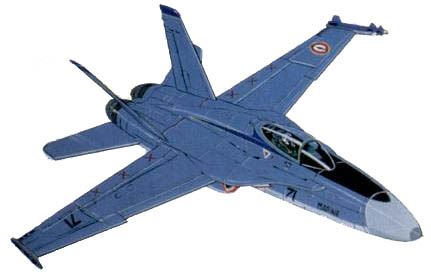 The French Navy openly
pronounced itself. "Only the F/A-18 would be able, as soon as
1993, to give carrier aviation defence strong capabilities, that
today are decreasing every day"(interview of vice-admiral Goupil,
Navy chief-of-staff, to Cols Bleus magazine in 1989). It is also
hard to believe "that the purchase of several second-hand aircraft
would endanger a new program of at least 400 planes". A Northrop
delegation came to Paris in September 1988, to back its offer of
40+ F-18(FN) for the French Navy. It was taken by CV Robert Feuilloy
(officer in charge of the nuclear carrier program in 1988-1989 for
the Navy headquarters) aboard the Foch aircraft carrier docked
at Toulon, and visited the ships aviation infrastructures.
The French Navy openly
pronounced itself. "Only the F/A-18 would be able, as soon as
1993, to give carrier aviation defence strong capabilities, that
today are decreasing every day"(interview of vice-admiral Goupil,
Navy chief-of-staff, to Cols Bleus magazine in 1989). It is also
hard to believe "that the purchase of several second-hand aircraft
would endanger a new program of at least 400 planes". A Northrop
delegation came to Paris in September 1988, to back its offer of
40+ F-18(FN) for the French Navy. It was taken by CV Robert Feuilloy
(officer in charge of the nuclear carrier program in 1988-1989 for
the Navy headquarters) aboard the Foch aircraft carrier docked
at Toulon, and visited the ships aviation infrastructures.
Experts and engineers from both the French Navy and Northrop concluded
that only a few minor modifications (worth as much of a F-18 at
the time) would be necessary on the carriers, mainly concerning
the catapults and jet blast deflectors. Furthermore, the elevators
were entirely compatible with the Hornet. Compatibility tests were
planned with two US Navy F/A-18C Hornets (VI Fleet) aboard the Foch (R99) during the month of August 1989, but the carrier docked for
the Mediterranean Sea on August 19th and mission Capselle. The Foch returned on September 25th, but no Hornet ever did land on its deck
or that of the Clemenceau, because the government abandoned
the program. 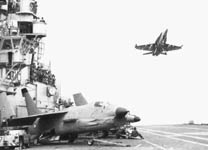 The killing of the French Hornet program was partly
compensated by the three fold decision to upgrade the F-8E Crusader
to the F-8P (P for Prolongé) standard, to allot the first
Rafales to the Navy and not the Air Force, and finally to readjust
the budgetary balance of the program in favour of the Navy. The
lease, or purchase of 20+ new or second-hand aircraft would
have allowed the Navy to wait for the ACM. However this
option was criticized by Dassault-Aviation, the national
manufacturer, which refused to see the Navy do such a move,
which would endanger the future of its own plane the Rafale.
Bruno Revellin-Falcoz, then vice Dassault president in
charge of technical matters, research and cooperation,
brought up the issue: "How can you ask French
manufacturers to develop a high performance combat aircraft,
and at the same time consider the purchase of a foreign
aircraft unable to respond to the requirements?".
The killing of the French Hornet program was partly
compensated by the three fold decision to upgrade the F-8E Crusader
to the F-8P (P for Prolongé) standard, to allot the first
Rafales to the Navy and not the Air Force, and finally to readjust
the budgetary balance of the program in favour of the Navy. The
lease, or purchase of 20+ new or second-hand aircraft would
have allowed the Navy to wait for the ACM. However this
option was criticized by Dassault-Aviation, the national
manufacturer, which refused to see the Navy do such a move,
which would endanger the future of its own plane the Rafale.
Bruno Revellin-Falcoz, then vice Dassault president in
charge of technical matters, research and cooperation,
brought up the issue: "How can you ask French
manufacturers to develop a high performance combat aircraft,
and at the same time consider the purchase of a foreign
aircraft unable to respond to the requirements?".
Yet the French Defence Secretary Jean-Pierre
Chevènement said he was waiting for "all
conditions to be gathered before taking, in due time, a
decision that had to be true to France's interest".
Vice-admirals Yves Goupil and Guirec Doniol had clearly said
that they wanted the F-18 to be a gap filler until the
arrival of the Rafale M and not, as they had been accused of
saying, a pure and simple replacement for the Rafale M.
One has to remember the Navy's stand at the time: its main
concern was to find a suitable fighter to defend the
carriers; keeping the Crusader, even with an important
upgrade would not be fit for the task. The Navy also
confirmed that the Hornet would only be a stopgap, and
insisted on the small number of aircraft required; 12 to 15
second-hand F-18s, with just enough lifetime left to wait
for the Rafale M.
 The decision to risk the absence of a decent interceptor or
not could only be a political one: indeed in November 1989
Chevènement met with his counterpart Dick Cheney
(current US Vice President), to discuss the possible
purchase of 15 aircraft. However on December 22nd 1989 the
government confirmed the Rafale M as the sole option for the
French fleet air arm. The outcome proved the two admirals
right. The Navy kept its Crusaders until December 1999,
after 35 years of service (not a record to be proud of), and
squadron 12.F only had 4 Rafale Ms on the day its
reactivation (May 18th 2001). Fifteen years had passed
between the type's first flight and the service entry of the
first plane, not a record to be proud of either.
The decision to risk the absence of a decent interceptor or
not could only be a political one: indeed in November 1989
Chevènement met with his counterpart Dick Cheney
(current US Vice President), to discuss the possible
purchase of 15 aircraft. However on December 22nd 1989 the
government confirmed the Rafale M as the sole option for the
French fleet air arm. The outcome proved the two admirals
right. The Navy kept its Crusaders until December 1999,
after 35 years of service (not a record to be proud of), and
squadron 12.F only had 4 Rafale Ms on the day its
reactivation (May 18th 2001). Fifteen years had passed
between the type's first flight and the service entry of the
first plane, not a record to be proud of either.
Un Hornet sur le porte-avions Charles de Gaulle

 Le 4 mai 2005, le groupe aéronaval constitué autour du porte-avions Charles de Gaulle appareille
du port militaire de Toulon pour une mission de deux mois
en Atlantique et en Manche.
Le 4 mai 2005, le groupe aéronaval constitué autour du porte-avions Charles de Gaulle appareille
du port militaire de Toulon pour une mission de deux mois
en Atlantique et en Manche.
Au cours de ce déploiement baptisé Frame 05, des interactions entre
groupes de porte-avions sont prévues avec l’United States Navy dans la continuité des exercices et des opérations
menées au cours des dernières années
(opération Héraclès en 2002, exercices
en Méditerranée en 2003 et mission Agapanthe
en 2004). 
 Le 22 mai, un avion de chasse F/A-18C
Hornet de l'United States Navy, le No400 du Strike Fighter Squadron VFA-131 "Wildcats"
de la NAS Oceana en provenance du porte-avions USS Dwight
D. Eisenhower (CVN-69) a apponté sur le Charles
de Gaulle aux mains du Capitaine Bud Bishop. Il
a été catapulté du bâtiment sans
aucune difficulté.
Le 22 mai, un avion de chasse F/A-18C
Hornet de l'United States Navy, le No400 du Strike Fighter Squadron VFA-131 "Wildcats"
de la NAS Oceana en provenance du porte-avions USS Dwight
D. Eisenhower (CVN-69) a apponté sur le Charles
de Gaulle aux mains du Capitaine Bud Bishop. Il
a été catapulté du bâtiment sans
aucune difficulté.
C’est la première
fois depuis les années 60 qu’un avion de chasse
américain apponte sur un porte avions français.
En outre, les marins français ont régulièrement l'occasion de se mesurer tant aux F/A-18C/D Hornet de l'United States Navy et de l'United States Marine Corps qu'aux récents F/A-18E/F Super Hornet de l'United States Navy lors d'exercices ou d'opérations de guerre au-dessus de l'Afghanistan.
|
sources - acknowledgements :
Vice-amiral Michel Debray,
attaché naval à Washington en
1976.
Amiral Guirec Doniol, chef du
Service Central de l'Aéronautique Navale en
1986-1989.
Capitaine de Vaisseau Robert
Feuilloy, officier de programme PAN en 1988-1989
auprès de l'Etat-Major de la
Marine.
Vice-amiral d'Escadre Yves
Goupil.
"Les Crusader Français en
action" Jean-Marie Gall - LELA Presse -
1997
Benoît
Marembert.
[PROJECTS MENU] [MAIN MENU] [HOME]
©French Fleet Air Arm. www.ffaa.net. All rights reserved.